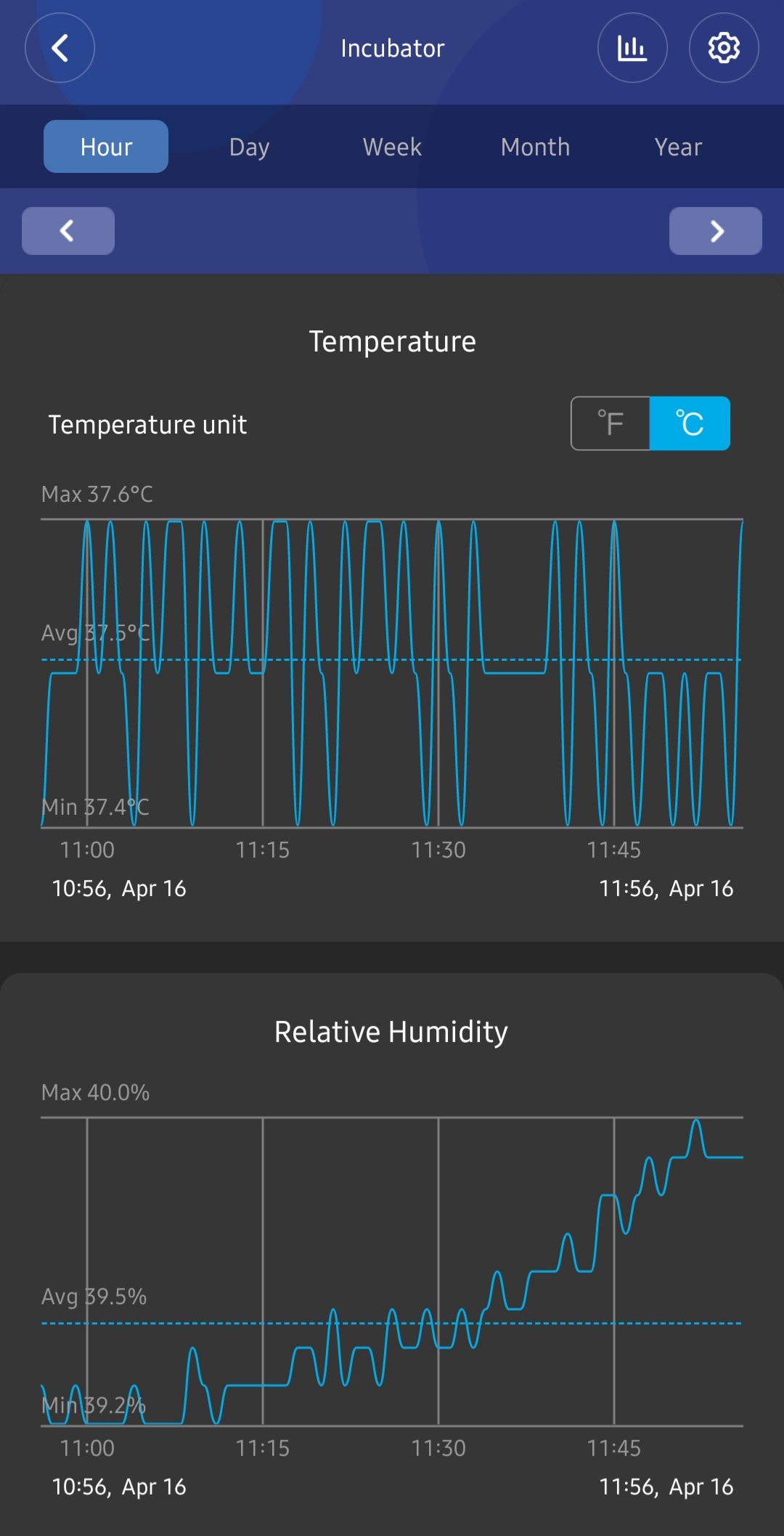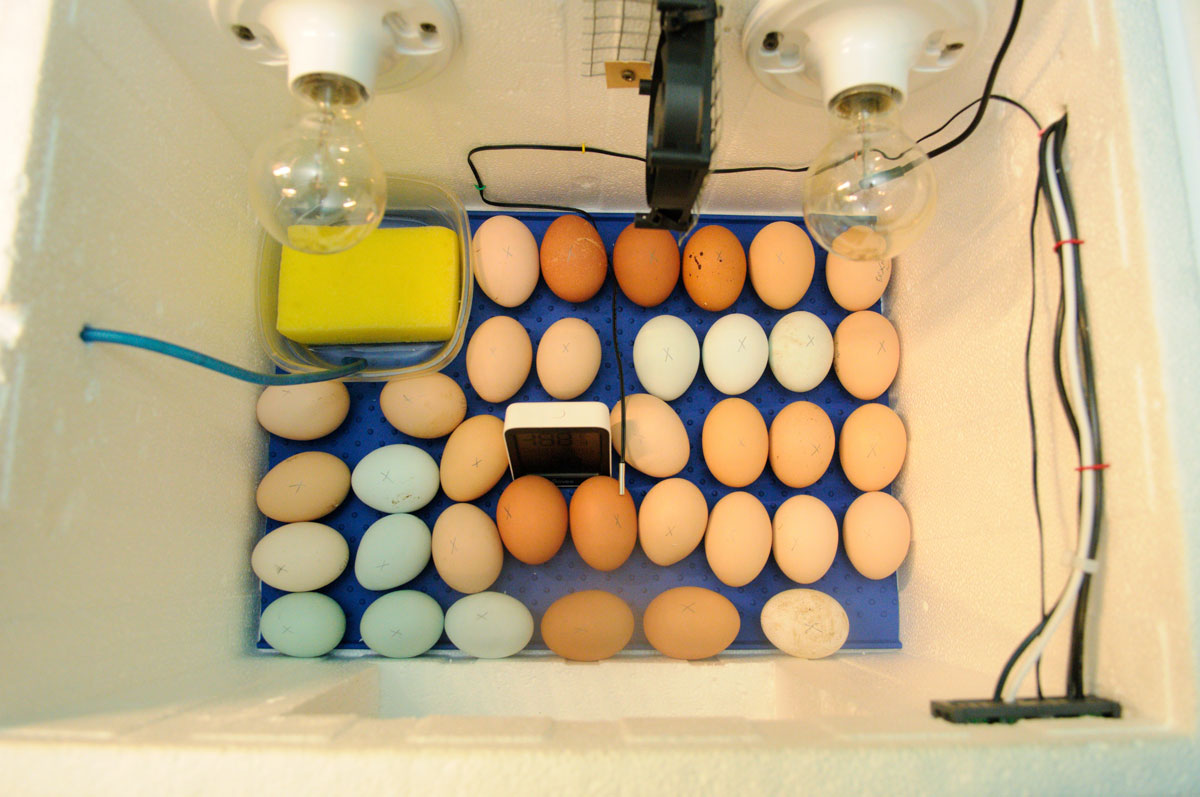It’s Go Time!
The Incubator is Filled to Capacity for its First Run
View all of my DIY incubator updates.
I ended up with hatching eggs a day earlier than planned due to a series of coincidences. They aren’t the eggs I had originally planned on hatching either but that is ok. We will (hopefully) have some adorable, fluffy chickens in about three weeks and that’s the important part. This is an incubator full of mainly barnyard mix birds.

The first dozen (front) is a mix of Barred Rock and Mystic Marans hens with a Mystic Marans rooster. Where the Mystic Marans is a cross between a Black Copper Marans and a Barred Rock, I expect the chicks that hatch from the Barred Rock eggs will look mostly like Barred Rocks seeing as they’d be 75% Barred Rock and 25% Black Copper Marans. The “pure” Mystic Marans could go either way between Barred Rock and Black Copper Marans where they don’t breed true. I’m hoping they keep the nice dark eggshells though.
The second dozen (middle) is a mix of Ameraucana, Sussex, Brahma, Barred Rock and Rhode Island Red hens with a Rhode Island Red rooster. There is the potential for a pure Rhode Island Red or two out of this dozen and there will definitely be some Easter Eggers courtesy of the Ameraucana hens, the rest should be mostly red or black with red on their heads.
The third dozen (back) is a mix of Gold-Laced Wyandotte, White Sapphire and one Leghorn hen with a Gold-Laced Wyandotte rooster. Seven of these eggs are pure Gold-Laced Wyandotte. I have no idea what Wyandotte mixed with Leghorn will look like and I’m not sure if the White Sapphire and Wyandotte mixes will lay brown or colored eggs so these will be surprises.
This is all hypothesized using my limited (but growing) knowledge of chicken genetics. If you’re reading this and know that I’m dead wrong, please correct me in the comments.
Now, about the incubator…
I’ve got the incubator working just about as close to perfectly as anyone could expect (you can see a readout from my digital hygrometer/thermometer a little further down the page) but it did take a bit of adjustment and I’ve learned a bunch already in the 18 hours or so the eggs have been incubating.
The first thing I learned is that it takes a LONG time to warm the eggs up from room temperature (about 18 degrees Celsius yesterday) to 37.5 degrees. It took just over 4 hours actually. I should have expected that but I didn’t and because I started them around 5:30pm yesterday it meant that I stayed up late keeping an eye on them to make sure everything was going to be ok. I was also up twice through the night to check them. Next time I will start them in the morning so I can obsess when I’m wide awake.
The second thing I learned is not to put the temperature probe directly on top of the eggs at first. This is what I did when I first turned the incubator on and the coolness of the eggs tricked the temperature probe into thinking it was MUCH cooler inside the incubator than it actually was. If I wasn’t watching, it would have just stayed on and cooked my eggs. I ended up having to suspend the probe just above the eggs to get everything to read properly. Now that everything is up to temperature, the probe is resting on the eggs again and all it fine. It’s just at the beginning that this is an issue.
The third thing I learned is that the eggs themselves raise the humidity in the incubator. Running it empty, I would lost 10-12% humidity over a 12 hour period without adding water. I have not added water since I put the eggs in and the humidity has stayed steady at 39% for 18+ hours. It’s definitely less maintenance to keep the humidity when the incubator is full.
And the last thing I’ve learned so far is that the temperature on the temperature controller needs to be increased slightly when adding eggs to maintain the proper temperature at the bottom where the eggs are. When empty my temperature controller’s temperature and the temperature on my digital thermometer matched each other. Since adding the eggs, I’ve had to turn the temperature controller up 0.2 degrees to have the temperature on the digital thermometer read where I want it to.
Below you will see a readout from my digital thermometer/hygrometer. I’m really happy that I bought this thing, it makes my data hungry brain happy and keeps me from getting out of bed to check the incubator in the middle of the night. If you’d like to have one too, you can get it on Amazon. That’s not an affiliate link, I don’t get paid if you buy it, I just think it’s awesome.
My goal was 37.5 degrees Celsius and 40% humidity for this stage. The temperature has been averaging 37.5 degrees Celsius. It has gone as low as 37.4 and as high as 37.6. The humidity has been consistent at 39%. Not too bad for a homemade incubator, I must say, and I’m definitely happy with it so far. Here’s hoping it continues to work this well until everyone hatches!

That’s it for now, I’m sure this won’t be the last incubator update though. I’m already anxious to candle the eggs next weekend and I’m sure I’ll be back to share how things are going then.


